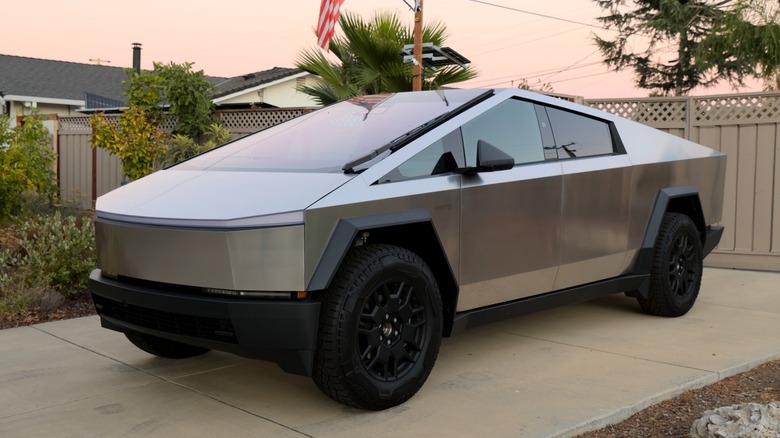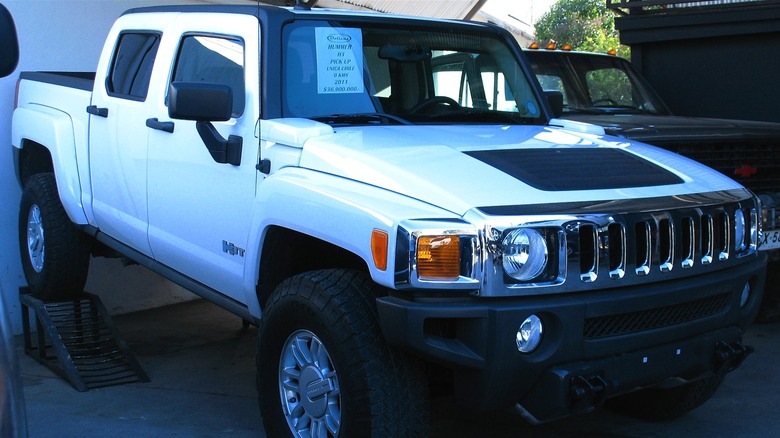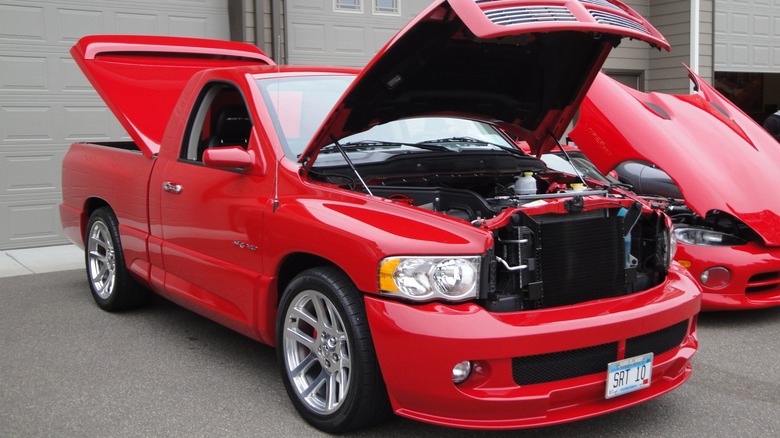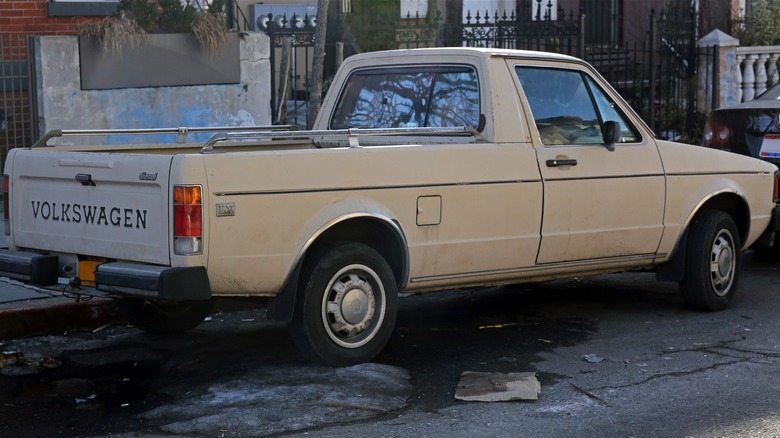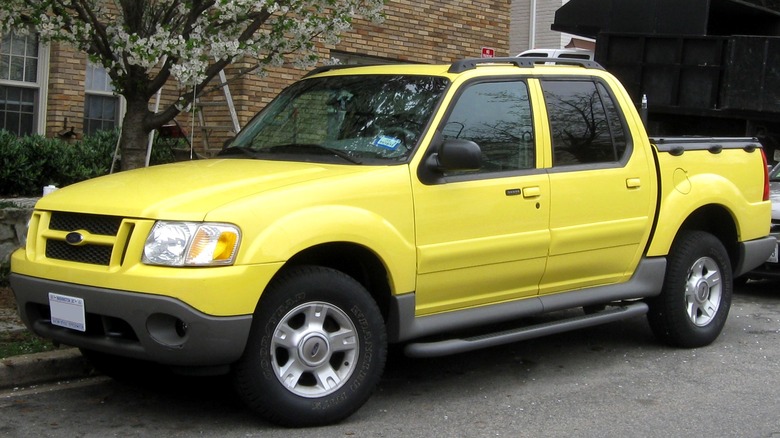10 Expensive Trucks That Look Cheap
Pickup trucks have come a long way over the past 30-odd years. In 1992, a Ford F-150 regular cab with an 8-foot bed measured about 213 inches in overall length. Today, that same truck is some 15 inches longer. With that increase in size has come an even more notable bump in price. The priciest entry point for our early 90s F-150 example was $17,453. Today, the cheapest F-150 starts at a shade under $39,000, while the top range, desert-racing Raptor will set you back at least $79,000 for the privilege.
That's a lot of dough, but it could be argued that the Raptor looks the 79 large part with bulging fenders, huge wheels, and ample exterior addenda pointing to its status atop the 2025 F-150 lineup. However, not all pickups fall into this category. Some — looking at you Cybertruck — are plenty expensive, but manage to look cheap. The list is long and goes as far back as the late 70s with trucks like the Rabbit Pickup that folks are ready to pay big bucks for today, no matter how chintzy it may appear.
Cheapness is being separated from coolness. In other words, I think a mint-condition VW Rabbit truck with a wheezing diesel and spartan cabin is as cool as they come. The same goes for epic sleepers like the second-gen F-150 Lightning. But do these pickup trucks have the expensive looks to go with the occasionally outrageous prices? Subjectively, I say they do not. This commentary may inflame my fellow enthusiasts, but just know, I dig most of these rides, even when they don't scream fancy.
GMC Syclone
Speaking of angering the enthusiast segment, I give you the GMC Syclone as an example of expensive trucks that look cheap. Before poo-pooing its value-to-styling ratio, let's have a look at the story behind the hotrod Syclone. Chiefly the 4.3L turbocharged V6 mill spitting out 280 horsepower and 350 lb-ft of torque courtesy of tidbits like a Corvette throttle body, special intake and exhaust manifolds, and that Mitsubishi snail huffing up to 14 psi of boost.
Back in 1991, this pickup truck from General Motors bested a Ferrari 348 in the quarter-mile. It was the stuff of gearhead dreams as were the sweet ground effects, 16" turbine-style alloys, 245 section-width Firestone Firehawks out back, and black velour cabin with red piping. Radical? Yes. Luxury styled? No. Car and Driver described it as "...your basic prairie ploughboy in Saturday-night-fever duds." Not exactly the kind of thing that comes to mind when laying eyes upon, say, a Ferrari.
As for the Syclone's price tag, it's no cheap date. When new, this GMC pickup stickered at nearly $26,000. The base price for the Sonoma on which the Syclone was based was much less than half that, at about $9,900. Things have gotten even more out of hand on this front with one particularly well-kept Syclone going for a heady $108,000 on Bring A Trailer in 2022. This doesn't change the fact that I want a Syclone very badly but wow — it does not look the six-figure part.
Tesla Cybertruck
Everyone's favorite whipping post for design, the gawky Cybertruck is easy to point fingers at. Forbes compares the Cybertruck's lines to the all-time-goofy Pontiac Aztek and says it's "ugly as sin". Motor Trend notes that the blocky Cybertruck is "... different merely for the sake of being different, and nothing is as unattractive as that." Given that it appears Tesla gave the final Cybertruck design reins to a blindfolded Boy Scout armed with a Ginsu knife and Pinewood Derby blank, I couldn't agree more.
Now, it must be said, the unfortunately styled Cybertruck does house impressive features under those triangular stainless steel panels. Headline metrics include up to 301 miles of driving range, 11,000 pounds of towing capacity, and the ability to do the 0-60 run in less than 3 seconds. The all-glass roof is cool and cargo space comes in at 120 cubic feet, though packing the bed in a way that would allow its hard tonneau cover to close seems guaranteed to cause a nervous breakdown.
With a current base price of $62,490, the Tesla Cybertruck leans expensive. But when you step up to the Cyberbeast and its super-neat three-headed dog badge, that figure comes in at basically $100,000, which is definitely expensive. For that outlay, you get a truck-like vehicle that appears to be homemade with glued-on fender flares and bumpers, and wheel covers that might be from the Mars rover. When you see a Cybertruck in the flesh, it seems to be a cartoon movie car that jumped from the celluloid into the real world, a la Roger Rabbit. Not my definition of an expensive-looking truck.
Lincoln Blackwood
Kudos to Lincoln for approving production of the Blackwood pickup truck. In theory, this oddball had the makings of a hit. Ultimately, however, it would have been better suited as a display piece at the SEMA show in Las Vegas given the overwhelmingly bizarre appearance. That theory was backed up the seemingly obvious combination of two industry titans circa 2002. The Lincoln Navigator was fairly new and tremendously popular, while the Ford F-150 was in one of its 47 years of sales success. One can almost imagine the boardroom meetings around enthusiastically blending the two into a luxury pickup truck.
The Detroit automakers certainly hit the luxury part of the brief. A 2002 F-150 crew cab had a starting price of $27,405. That year, the Lincoln started almost two times higher at $52,500, which played a big part in the Blackwood's failure. To justify this premium, Lincoln stuffed its new pickup with a host of high-end features. 18" wheels with low-profile tires, a power-operated tonneau cover hiding an illuminated stainless-steel cargo bed, a 5.4L V8, quad bucket seats, an Alpine Audiophile system, and so much more — including the Wenge wood-appearance exterior trim, split swing-out tailgate doors, and of course, the Navigator's front clip.
It's hard to say whether the odd combination of a Navigator front fascia and F-150 rear-end or the decidedly strange faux wood paneling was the main culprit for the Blackwood's head-scratching appearance. The Autopian called it "...one of the weirdest pickup trucks ever sold in America." To me, the Blackwood somehow managed to look cheaply tacked together, even though the number on the Monroney was anything but cheap.
Hummer H3T
Off-road fans will not like the inclusion of the Hummer H3T on this list — but it fits the bill. Produced at the end of the aughts, a 2010 H3T started around $36,000. A Chevy Colorado crew cab, from the same year, had a base price of about $24,000. In fairness, it's estimated that the Hummer only shared about 10% of its parts with the Colorado, but at a glance, it certainly appears to be a re-bodied Chevy. Some see the H3T as military chic, but $12,000 is quite a lot of money for a Colorado posing as a Hummer derived from a true military-spec Humvee.
Certainly, GM — I mean Hummer — gave the pickup truck variant of its H3 plenty of muscle to go with its off-road looks. The 5.3L V8 made 300 horsepower and 320 lb-ft of torque, though the standard inline-5 came with a manual transmission, which is just cool. Full underbody protection, recovery hooks at both ends, a dual-range transfer case, and the ability to ford up to 24 inches of water furthered this rough and tumble mission statement.
Unfortunately, in the H3T's attempt to look like its truly mean-looking H1 forebear, the results come off cheaply. Note the overly big fender flares, chunky front end, and particularly corny H1 Slantback-style tonneau cover option. The Hummer H3T may have off-road bona fides, but it came at a price and looked more like a Colorado attending a Hummer H1 cosplay convention than the expensive hardcore truck it wanted to be.
Dodge Ram SRT-10
Put away your pitchforks and blow out your torches, there's no need to freak out that the Dodge Ram SRT-10 shows up here. Believe me, I know how legendary this American muscle pickup truck is. The thought of piloting a Ram 1500 with a Viper engine and a 6-speed manual leaves me wondering how many organs I'd offer for harvest to experience such a thing. Dodge went absolutely wild with this truck — 500 horsepower and 525 lb-ft of torque from its naturally aspirated 8.3L V10 is enough to make an enthusiast's heart palpitate.
Car and Driver clocked a 2004 SRT-10 at 4.9 seconds to 60 on to a top speed of 153 mph. One marvels at the lurid burnouts such a truck could conjure. But we're here to discuss expensive trucks that look cheap, and the unfortunate truth is that the Ram SRT-10 qualifies. For starters, a quad cab variant stickered at $50,850 in 2004 while a regular ol' Ram 1500 quad cab came in at just $24,015. That's a crazy delta and for the average non-enthusiast consumer, learning you'd paid such a handsome sum for what appears to be a Ram with big wheels would likely be met with laughter.
Such is the burden of all-time sleepers like these Viper-powered Rams. You and I know it's worth the money, but boy it doesn't look like it is. The big hood scoop and the tailgate spoiler have JC Whitney catalog written all over them. The 22-inch rims, though glorious, somehow manage to be too big on regular cab SRT-10s. With its 6-foot bed, tall ride height, and gigantic wheels, the effect was cartoonish. Granted, quad cabs looked less silly with the extra length, but on the whole, the Ram SRT-10 looks cheaper than its big-time pricing would suggest.
Volkswagen Rabbit Pickup
At the other end of the performance spectrum is the tiny VW Rabbit Pickup, a truck-like thing that debuted way back in 1979. As with so many of the trucks here, I get the appeal of these simple throwbacks, but it has cheap written all over it. 13-inch steel wheels are the first obvious indication this wee pickup ain't fancy and after that, well, there's really nothing else adorning the exterior of the Rabbit-as-truck. I don't think too many folks would examine one and think it comes with a big price tag, particularly when fitted with the old-timey sloped roof cargo cap.
It's also kind of weird looking, which is perhaps to be expected when you chop a Mk1 Golf off at the B pillar and tack on a pickup truck bed. Unlike the Ram SRT-10, fans of the Rabbit pickup can't claim its sleeper creds change the narrative here. In base spec, these Rabbits came with a 1.6L diesel-powered inline-4 making just 52 horsepower. Or you could upgrade to the gas-powered 1.7L four-pot with its 78 horses ready to saunter up to 60 in... forever.
All that said, Volkswagen's odd take on the compact pickup truck was fairly priced at the time. With a base price around $6,600, it compared favorably with the period Ford Courier's $6,400 sticker. But times have changed and enthusiasts have gone haywire. As evidence, I present this 1981 Rabbit Pickup LX with the wheezebag diesel that traded hands for $33,000 in 2022. A cool little truck no doubt, but the hand-crank windows, spartan cabin, and plain Jane exterior simply do not have the pizazz to match that price.
Nissan Frontier Hardbody
In the 1980s, Nissan built its compact pickup truck with a double-walled cargo bed for durability, as in two sheets of separate metal versus the more common single sheet on its competitors at the time. It also sported a squared-off design that, in conjunction with the build quality, earned it the unofficial name Hardbody. With the iconic tri-spoke wheels, these old Nissans were as cool as they were tough. So, it's understandable that the Japanese automaker would look to capitalize on this history in modern times.
Enter the third-generation Nissan Frontier that debuted in 2022. The spiritual descendant of the Hardbody, these new Frontiers are undeniably capable compact pickups with a naturally aspirated 3.8L V6 and a 6,700-pound towing capacity. They're also quite nice inside with Nissan's Zero Gravity front seats, a central touchscreen interface, and options like a Fender 9-speaker audio system. But with creature comforts come big price tags and on that front, we look to the Hardbody package from 2024. Ticking this $3,900 box pushed the price point beyond $42,000, or $10,000 more than the base model that year.
Channeling an old classic like the O.G. Hardbody sounded exciting, but the execution didn't hit that mark. Big slabs of black plastic, oversized remakes of the 80s-era tri-point rims, and a just-okay bed-mounted sport bar fall into the meh category. Motor Trend called it a "Softcore version of the '80s original". For $42,000, I for one would like my Hardbody pickup to look, well, hard.
Ford F-150 SVT Lightning
Not the first-gen, not the EV, but the second-gen Ford F-150 with the Lightning nameplate is the one being referenced here. Sold at the turn of the millennium, these unique creations from the now-shuttered Ford Special Vehicle Department were that unusual combination of powerful, expensive, and cheaply styled. On the first front, these tuned F-150s were packing a supercharged 5.4L V8 built with a forged steel crankshaft and pistons, a 3" dual exhaust system, and an Eaton Gen IV roots-style blower that combined to produce 360 horsepower and 440 lb-ft of torque.
As for the price tag, the second-gen Lightning started at $29,355 or $13,000 dearer than a regular cab F-150 in 1999. More recently, that figure has gone as high as $63,000 at auction, which some of your non-enthusiast friends might find a touch crazy. Just take a look at the panel gaps wide enough to put a hand through or the way those 18" SVT 5-spokes and low-pro tires disappear within the enormous wheel wells. None of this is helped by the 1-inch front-end lowering and ½-inch rear-end lifting added by the factory. To the uninitiated, it all looks a bit second-rate
Factor in the bulging front air dam, garishly styled Lightning fender badge – replete with lightning bolt – and deeply scalloped bed side step, and you have a pickup that looks more boy racer street truck than jet-set 1 percent. Believe me when I tell you, I get why the second-gen Lightning is so special, but the styling could be interpreted as less than impressive. Even Car and Driver, who clocked these sleepers at 5.2 seconds in the 0-60 sprint, shared that some of their staffers "...think a high-performance pickup is dumber than bottled water."
Jeep Gladiator Sport
"It's a Jeep thing, you wouldn't understand," might be the first thing coming to mind when I say the Gladiator Sport belongs here. But I love Jeeps, especially the 1990 2-door Cherokee with a 5-speed that served as my first ride. Aside from its torquey straight-6, the best thing about that Jeep was that it was as cheap as it looked. This is relevant because the Jeep Wrangler nameplate arrived around the same time and over the 39 years since, it doesn't look much different. Enter the Gladiator, effectively a Wrangler with a pickup truck bed affixed to the rear end.
Seeing one of the Jeep pickups in, say, Rubicon form is an event. All bulgy and high riding, the thing looks the business and has a fat price tag to go with it. The same cannot be said of the base Sport model, which for 2025 starts at $38,695. That is a not-insignificant $7,300 higher than the entry point for a new Chevy Colorado. With the Gladiator, this high price gets you steel wheels and a design that looks like it's made out of Lego. Considering you can take off the doors and roof, and fold the windshield down, that's not too far off reality. Okay, steel Lego.
Naturally, this is part of the appeal of the Jeep Gladiator. However, the clunky exterior hinges, giant black plastic fender flares, removable canvas top, halogen headlights, and urethane steering wheel lend a cheap vibe to a midsize truck that is relatively expensive. Per Motor Trend, the Gladiator in Sport trim "looks about as long, low, and flat as an aircraft carrier" as opposed to the aggressive, trail-focused lines on the Mojave. Aircraft carriers are fantastic, but I don't want the design of my almost $40,000 pickup being compared to one.
Ford Explorer Sport Trac
Like Jeep, Ford has experimented with slapping a pickup truck bed on one of its popular SUVs. In this case, it was the Sport Trac that was produced over two generations starting in the early 2000s. I'll give the second-gen model a pass for dialing up the style to a respectable degree, but that first-generation Sport Trac is not pretty. In base trim, it rocked forgettable 16" tri-spoke steel wheels that were not great. Outside, it was big slabs of black plastic cladding stuck onto a 5-door Explorer with a short cargo box in place of a cargo bay.
Ford greenlit production of the Sport Trac after favorable reactions to its very expensive-looking 1996 Adrenalin concept. But that high-dollar vibe did not carry forward. The price tag, however, did as the 2004 Explorer Sport Trac cost $26,460 to start. A crew cab Chevy Colorado that year had a base price of $20,505 for comparison. Fully loaded, the first-gen Sport Trac could crack $30,000, as with the example Motor Trend reviewed — a truck that some of their staff found "...unattractive to the max." Unattractive and expensive-looking do not go together, which is just one more reason why the first-gen Explorer Sport Trac ends up here.


